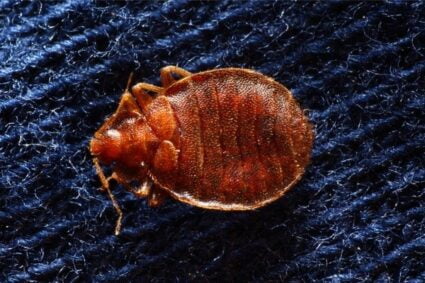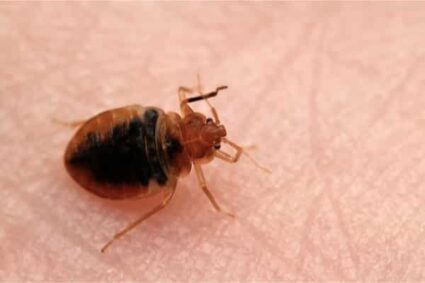Bed bugs are one of the worst kinds of pests that can infest your home. Because of this, it’s vital to learn how to tell if you have bed bugs early, to tackle this problem. Not only will you spend plenty of sleepless nights once you’re aware you have bed bugs, but these pests can cause bites that itch and swell. Treating a major infestation can also be very expensive.
When you run into a bottle of bed bug spray at your local home improvement store, don’t read the can and believe the hype. Getting rid of bed bugs can be a nightmare, and it’s going to take a lot more than a simple spray to get the job done.
You have to use several treatment techniques to eliminate them completely. You need to know where to look, and of course, the signs of an infestation so you can get a jump on treatment.
Fortunately, detecting an infestation is relatively simple as long as you know what to look for. With early detection, you can also prevent the females from laying more eggs and essentially doubling the population in just a matter of days. This also means that you’ll be able to prevent the bed bugs from spreading throughout your home.
Early Bed Bug Detection for Fast Results
To catch bed bug infestations early on and wipe it out quickly, it’s important to understand the process of pest detection.
Considering these pests are very small, they can easily hide in any crevice or small crack in the home. They can also remain hidden for months at a time, without feeding. Because of this, just because you haven’t spotted any bugs doesn’t mean you don’t have any in your home. It just means they may be hiding and biding their time.
If you’re not certain that you’re dealing with bed bugs and not some other type of pest, then your first step is learning about the common signs of bed bug infestations. The sooner these pests are detected, the better. If you’re not familiar with bed bugs in general and have never had to deal with an infestation, the following information will help to pinpoint what type of pest you’re dealing with.
What are the First Signs of Bed Bugs?
To fight these bugs, you need to learn how to identify them. Because these pests are so small, they’re commonly mistaken for ticks. However, while small, they’re still visible and can be easily distinguished from other insects of a similar size.
Correctly identifying them is essential because you need to use specific types of treatments to get rid of them. What may work to kill another type of pest may not be effective with bed bugs.
The size of these pests is one of their strengths because their size is what allows them to hide without being easily detected.
What Are the Most Common Signs of Bed Bug Infestations?
Itchy red bite marks are one of the most common signs that you’re dealing with an infestation, although many people mistake these bites for other insect bites, especially people who have dogs and cats and don’t use proper flea control medications. If you’re not sure about the source of the bite, meet with your doctor. Getting a formal diagnosis of bed bug bites is probably the easiest way to detect an infestation. They can also prescribe medication that can ease itching and prevent infection.
While the bed bug is feeding, their bite is painless. It’s after the bug has finished feeding on you that you’ll notice a raised bite, itching, and general discomfort.
Bed Bug Excretion and Shells
Bed bugs feed on human blood, yet they’re not able to digest all of it. A small amount of blood will be flushed out of their system and can be found in their excretion. The excretion looks like small dark spots. These spots can stain clothing and other types of material. Typically, you’ll see these spots on walls, baseboards, and even the ceiling.
If you notice these dark spots around your home, make sure you check the areas surrounding it. Often, you’ll find several dozens of bed bugs close by.

If you want to find out how to tell if you have bed bugs early, you should also look for discarded shells. These pests usually molt approximately one to two times per life cycle. This means, if you happen upon their exoskeletons this is a surefire way to detect a bed bug infestation.
If you do find shells, check the immediate area, looking in any crevices or cracks in the floors and walls, and check your furniture. This needs to be done quickly because these pests can breed and spread out very quickly, making early detection essential.
The Smell of Infestation
Did you know that an infestation of bed bugs can cause your home to smell? Often, a moderately sized infestation can cause a type of musty sweet smell to linger. To verify you have an infection, follow this scent to its source.
If you’ve checked off one or more of these early detection signs, then you’ll need to act quickly. Start off by inspecting your home, from room to room. It’s possible for the infestation to affect just one room, but the odds are you’ll need to treat your entire home since these bugs can easily hop on your clothing and hop off in another part of your home. Because of their small size, these pets can hide pretty much anywhere. However, they do prefer dark, warm spaces. Because of this, you need to carefully inspect your home and check for small openings and dark places where the bugs can hide.
How to Tell if You Have Bed Bugs in Your Mattress
Nothing can be more unsettling than the thought of tiny bugs feeding off your blood as you sleep. For some, once an infestation is detected in their mattress, throwing it out seems like the best, safest option. But if replacing your mattress isn’t an option, there are some methods you can use to get rid of these pests and prevent another infestation.
Those not familiar with bed bugs often mistakenly believe that this type of pest infestation is limited to beds only. Because of this, most people will throw their beds out believing that this will solve their infestation problem. However, it rarely does. Even if you toss out your bed, if your home is infested with bed bugs, then these pests will also get into your new mattress as well.
While bed bugs can be found in areas other than the bed, most of the bugs will be found in the box spring and mattress. Ditching the bed can be an effective way of making a dent in your infestation problem, but you’ll still need to treat the rest of your home to avoid the cycle repeating itself.
So, how can you tell if bed bugs have infested your mattress? Since these tiny bugs can hide inside your mattress, detecting them can be tricky. However, they do live off of your blood. So, if you have an unexplained itchy red rash, the first thing you should do is grab a flashlight and start checking your mattress for bed bug exoskeletons and excretion.
Treating Your Mattress
We don’t recommend treating your box spring and bed with pesticides unless the product you plan to use has been specifically designed for this purpose. Make sure you follow the directions for use carefully to avoid overexposure.
Even if the spray is designed for use on beds and furniture, you may have better luck using a vacuum and a steamer. This is because most sprays for beds are designed to kill bugs on contact, meaning it won’t kill any of the bugs that are hiding inside the mattress.
Using a combination of a steamer and a vacuum can effectively destroy and removes adults, eggs, and nymphs.
But even using these treatment methods won’t ensure that you get every egg and adult. Your best bet will be to purchase a bed bug cover for both the box spring and mattress. These thick plastic covers will completely encase the box spring and mattress, suffocating any remaining bed bugs. When the eggs hatch, they will also be suffocated.
If you’ve used a steamer on the mattress, it’s important to wait approximately twenty-four hours before applying the covers to avoid mold growth. Once the mattress is fully dry, then apply the covers and ensure they’re tightly sealed.
Additionally, these covers will only work if they’re completely sealed. Even a small puncture can render the covers useless. Carefully inspect the covers every time you change your sheets and promptly replace them if you notice any damage.
This is a great, all-natural bed bug treatment that will prevent them from spreading and infecting other areas of the home. Of course, in severe cases, it may already be too late.
Early Bed Bug Infestation Treatment
As we previously mentioned, the bed bug’s size gives them an advantage, making them difficult to spot and allowing them to hide in tight, small spaces all throughout your home.
Because of how difficult it is to spot them, you should consider doing regular inspections. A couple of times a month, carefully inspect your home to prevent reinfestation. Remember, early detection is key.
By following the detection tips we have provided, you’ll be able to detect bed bugs early, when the infestation is still manageable. However, detecting them is one thing and eliminating them is another.
There are several ways you can go about tackling your bed bug problem. Early bed bug infestation treatment will help you manage the infestation and prevent the pests from laying eggs and spreading. Some homeowners recommend using a bed bug spray, since its merely a matter of pointing and spraying, while others argue that using certain household chemicals, such as bleach for bed bug infestations.
If you plan on using a spray, remember that not every bed bug spray will work. Some products tend to work better than others. Choose a product that has been proven effective to avoid wasting money and time. We’ll cover exactly what types of sprays to use, later in our guide.
First things first, you need to focus on making your home easier to treat.
Cleaning Up Before Treating an Infestation
If you’re dealing with a significant infestation, then thoroughly cleaning your home can seem like a daunting, impossible task. But if you take a multi-treatment approach and clean to declutter, vacuum, steam clean, and use sprays and powders, you should be able to get rid of these tricky pests easily.
Unfortunately, these pests can hide in all types of tight spaces in your home such as inside books, in cracks in the wall or floors, inside your couch cushions, and in your carpet. Before you decide to spray, use bleach, or steam clean your home, your first step should be to clean it.
Cleaning will help to cut down on the bed bug population and can make it difficult for them to hide.

Start off by getting rid of the clutter in each room. This can include personal belongings such as laundry, books, magazines, and anything else left on the floor. This type of clutter makes it easier for the bugs to hide.
Any of your clothing that has been left out should be washed and dried. If you don’t wear these clothes often, store them inside vacuum sealed bags or garbage bags.
Vacuuming and Steaming
Vacuuming is the next step in the cleanup process. Even your hardwood or tile floors should be vacuumed. If you have area rugs or throw rugs, wash the throw rugs and vacuum and steam treat the area rugs. You’ll want to vacuum along the baseboards, vacuum the furniture and any other surface you can think of. After you’ve finished vacuuming, empty the canister or change the vacuum bag, tossing it outside.
Steam cleaning is another great option and one you should use after you’ve finished vacuuming. A steamer can be used to treat cabinets, baseboards, furniture, couches, chairs, and drapes. When steam cleaning, you’ll need to slowly move the nozzle, focusing on one inch of footage per second. This will ensure that all of the eggs, nymph, and adults are killed.
If you’re worried that bugs are hiding in specific items that you can’t wash or use the steamer on, such as shoes, luggage, books, or paperwork, then you can use a bed bug heater to treat them. These portable heaters are a very popular and effective way to heat treat your items, safely. They can also be used as a preventative measure.
Powders and Sprays
This is where sprays come in. Using sprays and powders can be an effective way to eliminate any bugs you may have missed with the first two steps of the cleaning process. You should use a combination of residual and contact sprays. You can also purchase powders, which will ensure that you instantly kill any bed bugs in the areas and will work to continue killing the bugs over time, in the event you’ve missed any eggs.
Contact sprays are designed to kill these bugs immediately so that they won’t offer any lasting protection. Start by spraying along dresser drawer slides, along baseboards, behind your bedroom furniture including the dresser and headboard, and along the baseboards in your closets.
You’ll want to follow up with a residual spray immediately after where you hit all of the same areas. These sprays will provide long-lasting protection against any hatchlings and work well in crevices and cracks. Some types of specialized residual bed bug sprays are also an excellent choice for furniture, while others are specifically designed for hard surfaces such as baseboards and floors.
Both the residual sprays and contact sprays should not be used in any area you’ll sit on, walk on, or touch. Unless, of course, the sprays state that they’re safe for use on couches and chairs.
Most of these bed bug sprays are designed to reach deep down into any hiding spaces bed bugs may be lurking. If you’re dealing with a significant infestation throughout your home, keep in mind that this type of self-treatment option can be pricey.
After you’ve used both types of sprays, begin applying the powder into any confined spaces where the powder won’t easily be stirred into the air. Regarding where the powder is best applied, pros recommend light switches, outlets, wall voids, and deep cracks in the floors and walls, since sprays are not able to effectively reach these areas. You can use a professional grade powder applicator which will give you better control over the application process.
How to Prevent Bed Bugs from Spreading
After a two week period, we recommend reapplying both of the sprays. This reapplication will ensure that any eggs that managed to survive and hatch after the first round of treatment will be killed off and unable to spike a new infestation.
You won’t have to use more bed bug powder since this type of powder is designed to work for several weeks as long as the treated area remains dry.
Following these cleaning, vacuuming, steaming and spray and powder steps will have you pest free in a matter of a week or two. Make sure you always keep these products on hand in the event of a new infestation.
Is it Hard to Get Rid of Bed Bugs?
As you can see, getting rid of bed bugs isn’t easy. You’ll need to hire a professional exterminator or use a multi-tiered attack and repeat treatment. But without the use of harsh insecticides, you may need to repeat treatment every couple of weeks for two to three months if you’re dealing with a severe infestation.
Is it hard to get rid of bed bugs for good? In some cases, yes. These tiny pests tend to multiply at a rapid rate. Since they can go very long periods of time without food, it makes them even more difficult to track and kill.
The bugs themselves are the size of lentils, featuring a flat, tough, small body that allows them to easily squeeze into the tightest spaces such as floorboards, outlets, and even behind loose wallpaper. To successfully get rid of them, you have to kill every single bug and destroy every egg. When you put it like that, it does sound almost impossible.
Did you know that just one female bed bug is capable of laying over five hundred eggs during their lifetime? In as little as eight weeks, the female’s offspring can lay eggs, continuing the infestation cycle.
These bugs can also reproduce more successfully in temperatures ranging from seventy to eighty degrees. Unfortunately, most people often keep their homes in this temperature range.
Research has also shown us that in some cases, the bed bug can survive without nourishment for over a year. Their offspring, the nymph, can go up to two months without food. Because of this, you can to keep going back and repeating treatment.
Learning how to tell if you have bed bugs early is a surefire way to handle the infestation before it gets out of control. A minor infestation may not even require repeat treatment if you follow the tips we have included here and keep an eye out for early signs that you’re dealing with a bed bug problem. Using our multi-tiered approach will ensure you get every nook and cranny in your home and get those pests right where they live.


Can I send a pic to someone to verify before I contact landlord?
What kind of powder do I get